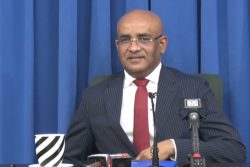Last week, in the run up to World Suicide Prevention Day, which was observed on September 10, the Ministry of Human Services revealed statistics which were not really that surprising. For years, Guyana has been listed among the countries with the highest suicide rates in the world (counted as the number of suicides per 100,000 deaths). Currently it is in second place at 40.3 per 100k behind the southern African country Lesotho with 72.4.
Guyana’s suicide figure was pegged at 44.2 in a 2014 Word Health Organisation report, which was four times the global average. It dropped the next year, possibly in response to strategies that were put in place following the publication of that report, but each year since then it has been steadily climbing: 2016 – 37.9, 2017 – 38.5, 2018 – 39.5 and 2019 – 40.3. Data for 2020 does not appear to be available as yet. However, according to the Human Services Ministry, for the first half of this year, there were 147 suicides; 120 were men, 19 were children between the ages of five and 19 years old and 109 people between the ages of 20 and 60 years old.
In its statement, the Human Services Ministry drew a parallel between the impact of the COVID-19 pandemic on mental health and the local suicide numbers, but did not produce the evidence — for example, rates higher than 40.3 in 2020 and 2021 to date — to support this. There is no doubt that the novel coronavirus is responsible for a lot of the physical and mental turmoil currently surrounding us, but the Human Services Ministry should take care to base its proclamations on facts and hard data, particularly at this time where there is so much uncertainty. It is irresponsible to do otherwise.
That being said, the crisis wrought by COVID-19 has had a devastating effect on people’s lives globally and several countries have compiled statistics revealing increases in mental health issues that have led to suicide and attempted suicide, particularly among children. This is based on the fact that those numbers have been rising over the period of the pandemic as well as interviews with mental health professionals who have interacted with children and young people following impulsive attempts at fatal self-harm.
The consensus is that last year’s sudden change in routine, the lack of face-to-face interaction with teachers and peers, coupled with the deaths of parents and loved ones in some instances, has had a dire psychosocial effect on children and young people. Suddenly, the world is no longer what they knew it to be and this occasioned distress, anxiety, fear and in many cases, depression. These issues, compounded by abuse, lack of self-worth, bullying, confusion over identity and isolation among other ills that were part of their lives even before the pandemic, could perhaps explain the reason behind the increases in suicide, suicide attempts and suicidal thoughts.
It is well known that part of the solution to any issue is recognising or admitting there is a problem and then finding the means to address it. The link between suicide and mental disorders has long been well established. Yet, attention to mental health has been slow to gain priority due in part to a lack of awareness of it as the major public health issue it is, though that has begun to change. However, there is stigma attached to mental disorders and suicide and in some jurisdictions even discussing either issue is still taboo.
Prevention efforts must therefore encompass all of these factors. In addition they must be tailored to reach different groups. Strategies that might be effective at grappling with suicidal tendencies in men, for example — a high-risk population here in Guyana — would not have the same effect if applied to women or children. Different approaches have to be taken too, when targeting suicide and mental health problems among Indigenous people. Furthermore, within every population classification, there are subgroups, for instance LGBTI people, who would require specifically targeted actions.
Before all of this, however, there has to be a starting point which should be based on quality data. Extrapolating what is happening elsewhere and applying it to a local situation can only serve to defeat the purpose, which is preventing suicide.
The Ministry of Human Services said as much in its statement, observing the need for frank dialogue, the importance of reaching out to loved ones for friends who might be overwhelmed by one thing or another, and highlighting the availability of the 914 hotline. What it failed to zero in on is the lack of openness in our society which might stymie dialogue and hamper the ability to reach out. However, these are issues that can be worked on and one hopes those in authority have taken note and are really taking a holistic approach to stemming local suicide rates.









